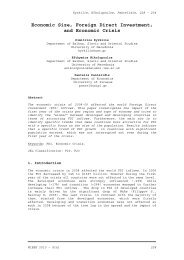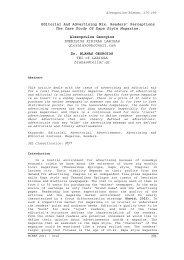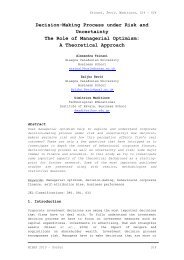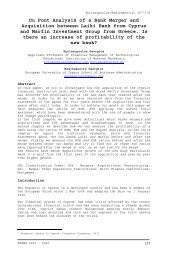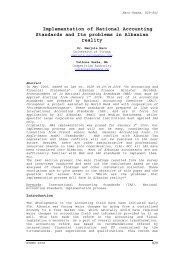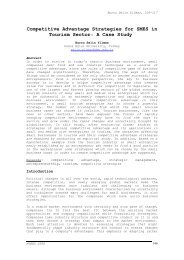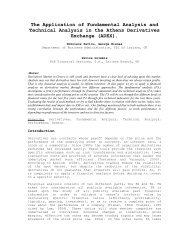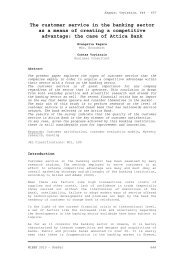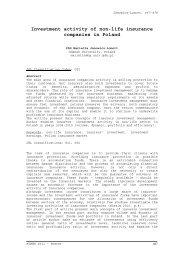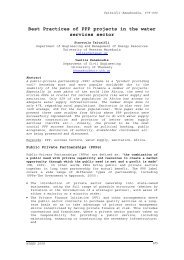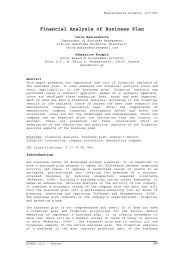roles and responsibilities in the Greek Industry - mibes
roles and responsibilities in the Greek Industry - mibes
roles and responsibilities in the Greek Industry - mibes
You also want an ePaper? Increase the reach of your titles
YUMPU automatically turns print PDFs into web optimized ePapers that Google loves.
Madit<strong>in</strong>os-Kokk<strong>in</strong>os-Papadopoulou, 437-444<br />
<strong>the</strong> organisational <strong>and</strong> structural possibilities for fill<strong>in</strong>g that role<br />
(Robson, 1997). Accord<strong>in</strong>g to Hoffman (1998) <strong>the</strong> firms reshape <strong>the</strong> IS<br />
executive role itself <strong>and</strong> many of <strong>the</strong>m looked for outsourc<strong>in</strong>g<br />
solutions (Applegate <strong>and</strong> Elam, 1992).<br />
In this study, a survey took place <strong>in</strong> order to <strong>in</strong>dentify <strong>the</strong> role, <strong>the</strong><br />
<strong>responsibilities</strong> <strong>and</strong> <strong>the</strong> nature of contacts of <strong>the</strong> CIO <strong>in</strong> <strong>the</strong> <strong>Greek</strong><br />
<strong>in</strong>dustry. Throughout this survey, primary data from several <strong>in</strong>terviews<br />
<strong>and</strong> observations were ga<strong>the</strong>red from fifty large <strong>in</strong>dustrial plants <strong>in</strong><br />
Greece.<br />
Theoretical Background<br />
The <strong>in</strong>ternal need of <strong>the</strong> companies to develop capabilities through <strong>the</strong><br />
<strong>in</strong>tegration of <strong>the</strong>ir technical resources; <strong>and</strong> also, <strong>the</strong> external new<br />
competitive bus<strong>in</strong>ess challenges <strong>and</strong> opportunities have motivated<br />
bus<strong>in</strong>ess executives to count on <strong>the</strong> IS executive to use <strong>the</strong> IT<br />
resources of <strong>the</strong> company for driv<strong>in</strong>g strategic change. Thus, <strong>the</strong><br />
extraord<strong>in</strong>ary growth of <strong>the</strong> importance of <strong>the</strong> IS with<strong>in</strong> bus<strong>in</strong>ess<br />
organisations compelled <strong>the</strong> orig<strong>in</strong>al role <strong>and</strong> <strong>the</strong> <strong>responsibilities</strong> of<br />
<strong>the</strong> IS manager (more likely data process<strong>in</strong>g-technology manager) <strong>in</strong> <strong>the</strong><br />
1950s <strong>and</strong> 1960s to be changed <strong>and</strong> evolved.<br />
The role of <strong>the</strong> CIO<br />
In <strong>the</strong> beg<strong>in</strong>n<strong>in</strong>g, IS managers worked <strong>in</strong> major companies as functional<br />
heads <strong>and</strong> <strong>the</strong>ir role was more technology-centric, closely to <strong>the</strong> role<br />
of a computer educated technician. In <strong>the</strong> end of 1970s, <strong>the</strong> MIS<br />
(Management Information Systems) had been even more matured <strong>and</strong> <strong>the</strong><br />
role of <strong>the</strong> MIS managers had been connected with <strong>the</strong> measures of<br />
system efficiency <strong>and</strong> cost reduction (Ives <strong>and</strong> Olson, 1981). By <strong>the</strong><br />
beg<strong>in</strong>n<strong>in</strong>g of 1980s, MIS managers exhibited tendency for provid<strong>in</strong>g <strong>the</strong><br />
CEOs with important <strong>in</strong>formation regard<strong>in</strong>g <strong>the</strong> adaption of <strong>the</strong><br />
organisation to new technologies (Rockart, 1980). Then <strong>in</strong> <strong>the</strong> mid-<br />
1990s, <strong>the</strong> title of CIO was <strong>in</strong>troduced to describe a new type of IS<br />
executive <strong>in</strong> a C-level position. The CIOs became strategic partners<br />
for align<strong>in</strong>g IT with bus<strong>in</strong>ess <strong>and</strong> many studies revealed that an<br />
<strong>in</strong>creas<strong>in</strong>g number of CIOs reported directly to <strong>the</strong> CEO <strong>and</strong> over half<br />
became senior managers (Feeny, Edwards <strong>and</strong> Simpson, 1992; Chun <strong>and</strong><br />
Mooney, 2009). CIOs had begun to undertake activities to achieve <strong>the</strong><br />
objectives of <strong>the</strong> organisation (Robson, 1997). Eventually, <strong>the</strong>ir role<br />
differed from <strong>the</strong> role typically referred to as MIS manager <strong>and</strong> <strong>the</strong>y<br />
operated more as executives ra<strong>the</strong>r than functional managers (Stephens<br />
et al., 1992). Fur<strong>the</strong>rmore, Jordan (1993) stated that CIO is concerned<br />
with a wider group of issues than are most managers. In <strong>the</strong> 2000s, <strong>the</strong><br />
CIOs turn <strong>in</strong>to bus<strong>in</strong>ess visionaries <strong>in</strong>itiat<strong>in</strong>g bus<strong>in</strong>esses to change<br />
processes <strong>and</strong> strategies with <strong>the</strong> use of IT (Rockart, 1980; Enns, Huff<br />
<strong>and</strong> Golden, 2003; Feeny, Edwards <strong>and</strong> Simpson, 1992). CIOs began to<br />
diversify <strong>the</strong>ir <strong>responsibilities</strong> <strong>and</strong> <strong>the</strong>y came closer with <strong>the</strong><br />
bus<strong>in</strong>ess units <strong>in</strong> order to take advantage of <strong>the</strong> opportunities <strong>in</strong> <strong>the</strong><br />
marketplace.<br />
MIBES 25-27 May 2012 438



